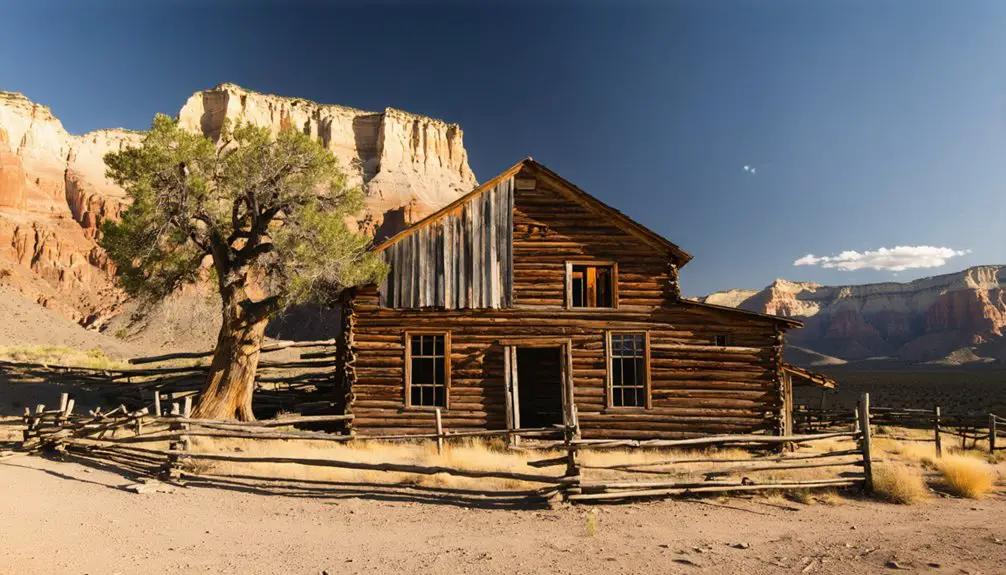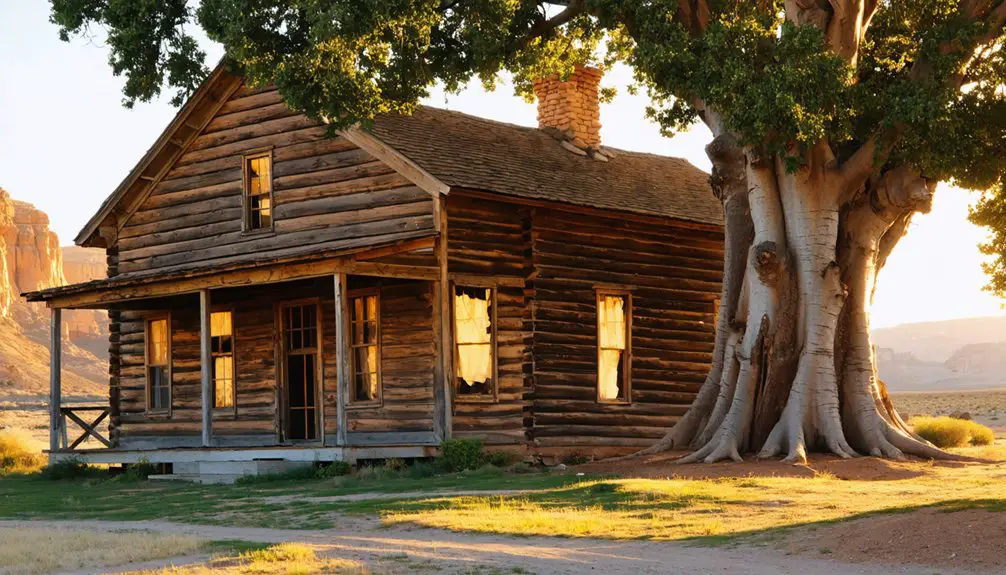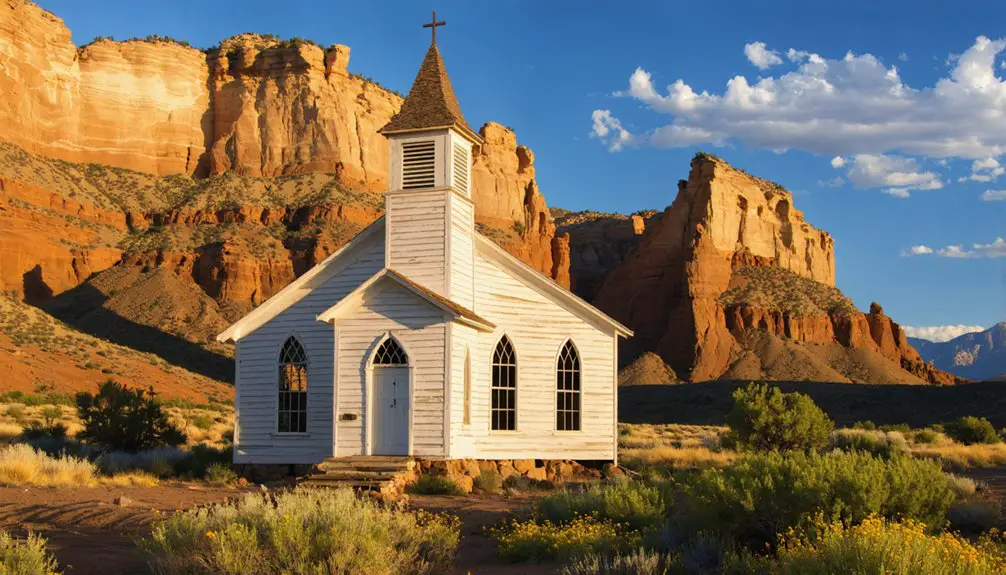You’ll discover Grafton ghost town in southern Utah’s red rock country, where Mormon pioneers established a settlement in 1859. Their community thrived initially through cotton farming and peaceful trading with Southern Paiute tribes, but faced devastating Virgin River floods and conflicts during the Black Hawk War. By 1921, residents had abandoned Grafton completely. Today, you can explore its well-preserved buildings, historic cemetery, and iconic landscape – famously featured in “Butch Cassidy and the Sundance Kid.”
Key Takeaways
- Grafton, Utah is a preserved ghost town established in 1859 by Mormon settlers near Zion National Park.
- The town was abandoned by 1921 due to devastating floods, irrigation problems, and conflicts with Native Americans.
- Famous structures include a restored historic church, the Russell Home, and a cemetery containing 77 pioneer graves.
- The site gained fame as a filming location for movies, including “Butch Cassidy and the Sundance Kid” (1969).
- The Grafton Heritage Partnership now preserves 150 acres of the historic townsite and maintains active agricultural operations.
The Mormon Settlement Legacy
As part of Brigham Young’s ambitious plan to establish a Mormon sanctuary in the American West, Grafton emerged in 1859 when five families relocated from Virgin to settle along the Virgin River. Their arrival marked another milestone in the broader Mormon migration that established roughly 500 villages across the western territories between 1847 and 1900.
You’ll find Grafton’s story deeply rooted in Young’s vision of creating a self-sufficient “state” of Deseret, where church members could escape persecution. The settlement’s focus on communal agriculture, particularly cotton farming through the Cotton Mission initiative, reflected this drive for independence. The community grew rapidly, reaching 168 residents by 1861. The Southern Paiute tribes had inhabited the region long before the Mormon settlers arrived.
When Navajo raids threatened the area in 1866, Young’s strategy shifted to consolidating villages for better defense. Despite temporary evacuations, Grafton’s determined settlers returned, demonstrating the resilient spirit that defined Mormon pioneering efforts.
Nature’s Relentless Challenge
While Grafton’s settlers faced numerous challenges, none proved more formidable than the relentless forces of nature. The Virgin River’s frequent floods wreaked havoc on farmland, while heavy silt deposits clogged irrigation systems, demanding constant maintenance. Similar to many other places named Grafton, the settlement struggled against environmental hardships unique to its location.
Nature’s fury defined life in Grafton, where raging floods and endless silt turned farming dreams into a constant battle for survival.
The 1862 massive flood devastated the community and marked a turning point in the town’s history. These natural disasters, combined with harsh desert conditions and seasonal weather extremes, created an environment where survival demanded extraordinary resilience.
- Your crops could be washed away mere months after planting
- You’d spend countless hours dredging irrigation ditches weekly
- Your isolation meant limited help during environmental challenges
- Your farming efforts were constantly undermined by poor soil conditions
- Your family’s safety was threatened by unpredictable flooding
These persistent environmental challenges eventually forced residents to abandon their dreams of prosperity in Grafton, leading to their migration toward more stable communities like Hurricane and Rockville.
Frontier Life and Native Relations
You’ll find that Grafton’s early years featured peaceful trading between Mormon settlers and Native Americans, particularly the Southern Paiute tribes.
Competition for grazing land and water resources eventually sparked tensions between the groups, leading to raids and violent confrontations in the mid-1860s.
The escalating conflicts ultimately forced Grafton’s residents to abandon their homes in 1866, though they’d return two years later after peace agreements were established. Brigham Young’s philosophy of feeding the Indians instead of fighting them helped maintain peace in the region during these challenging times. A stark reminder of these conflicts remains in the Berry headstone at Grafton Cemetery.
Early Peaceful Trading Days
During the early days of Grafton’s settlement in 1859, Nathan C. Tenney and fellow settlers established a community that embraced peaceful relations with local Native Americans.
You’ll find that these early interactions focused on mutual understanding and trade customs that benefited both groups.
- Native Americans shared crucial knowledge about farming in the harsh Virgin River climate
- Settlers learned indigenous techniques for water management and crop cultivation
- Cultural exchanges helped both communities survive the challenging frontier conditions
- Trade relationships developed naturally as goods were exchanged between groups
- Mormon missionaries like Tenney fostered communication and understanding
The Cotton Mission’s success in 1854 at nearby Santa Clara helped shape Grafton’s early agricultural focus.
The settlement’s communal approach to living, centered around faith and cooperation, created an environment where peaceful trading could flourish.
This foundation of respect allowed settlers to establish their homes while maintaining positive relationships with indigenous neighbors.
The community grew steadily until reaching its peak of 168 residents in 1864, demonstrating the success of their cooperative approach.
Overgrazing Sparks Tensions
As Grafton’s settlers introduced large numbers of livestock along the Virgin River in the early 1860s, their intensive grazing practices began disrupting the delicate ecological balance that local Native American tribes had maintained for generations.
The overgrazing consequences were severe. You’d have seen Southern Paiute and Navajo peoples struggling as their traditional hunting and gathering grounds became depleted. Resource competition intensified when settlers’ cattle consumed vegetation essential for native subsistence. The area remained troubled until peace was restored in 1868.
By December 1865, tensions erupted into violence when Navajo raiders targeted livestock near Kanab and the Shirts ranch. The situation deteriorated further in January 1866 with the killing of two ranchers at Pipe Spring, triggering a cycle of raids and counter-raids. The town struggled to maintain its cotton farming operations while dealing with these escalating conflicts.
This dangerous environment ultimately forced Grafton’s residents to temporarily abandon their settlement and seek refuge in nearby Rockville.
War Forces Mass Exodus
The mounting tensions over grazing rights erupted into full-scale warfare by late 1865.
You’d have witnessed violence escalation as Navajo raiders struck Kanab and Shirts ranch, followed by deadly attacks at Pipe Spring.
The situation became so dire that Brigham Young ordered a mass migration, forcing you to abandon your home in Grafton and consolidate in Rockville for protection.
- Your daily life became a dangerous game of survival
- You’d risk death just to tend your crops each day
- Your neighbors fell victim to brutal raids and killings
- Your community scattered, leaving homes behind
- Your world turned upside down until peace came in 1867
The mass exodus weakened Grafton’s population considerably.
Though some residents returned by 1868 after peace negotiations with Black Hawk, the town never fully recovered from this tumultuous period.
The Path to Abandonment

Once peaceful relations with Native American tribes deteriorated in the 1860s, Grafton’s path to abandonment began through a combination of environmental disasters and security threats.
You’ll find that repeated flooding devastated irrigation systems and crops, while the Black Hawk War forced residents to flee between 1866-1868. Though some returned after peace was restored, the town’s economic struggles intensified as cotton cultivation failed and younger generations sought opportunities elsewhere.
Despite attempts to adapt by switching to food crops, you couldn’t ignore the harsh reality of farming in the Virgin River’s unpredictable floodplain.
The population steadily declined as residents moved to safer, more prosperous communities. By 1921, you’d have found Grafton completely abandoned, its buildings left to deteriorate under the desert sun.
Hollywood’s Desert Backdrop
While most ghost towns faded into obscurity, Grafton’s striking desert scenery and authentic frontier buildings caught Hollywood’s attention in the late 1920s.
You’ll find this cinematic appeal showcased in films like “In Old Arizona” (1929), “The Arizona Kid” (1930), and most famously in “Butch Cassidy and the Sundance Kid” (1969).
- The dramatic backdrop of Mount Kinesava frames every shot with rugged grandeur
- Virgin River’s meandering path creates a stunning contrast against the desert landscape
- Historic brick buildings transport you back to authentic frontier life
- Lush green pastures and orchards break the harsh desert monotony
- Preserved ruins symbolize the untamed spirit of the Old West
These film locations near Zion National Park helped establish Southern Utah as “Little Hollywood,” cementing Grafton’s legacy in Western cinema.
Preserving a Piece of Pioneer History

Beyond its Hollywood fame, Grafton stands as a tribute to dedicated historic preservation efforts spanning several decades.
You’ll find the results of remarkable historical preservation work that began in 1997 when the Grafton Heritage Partnership formed to protect this pioneer settlement. Through community involvement, they’ve successfully restored key structures including the old church, Russell Home, and Louisa Foster Home.
The partnership raised over $1.35 million to secure 150 acres of surrounding farmland, maintaining Grafton’s authentic rural character.
Through successful fundraising efforts, the Grafton Heritage Partnership preserved vast farmlands, ensuring the town’s historic pastoral setting remains intact.
You can explore the preserved wooden buildings among tree-lined fields that reflect the original pioneer environment. A 24-hour surveillance system protects the site from vandalism, while active agricultural operations continue on the preserved land.
The historic cemetery, with its restored wooden fences and 1860s headstones, offers a poignant glimpse into pioneer life.
Tales and Legends of Old Grafton
Life in Grafton unfolded as a demonstration of pioneer resilience, marked by both triumphs and tragedies since its 1859 founding by Mormon families.
As you walk through this historic ghost town today, pioneer spirits echo through the remaining structures and cemetery grounds, telling tales of determination and loss.
- The Ballard family’s heartbreaking story of losing five children under age ten
- The Berry family’s devastating loss of three brothers and a sister-in-law in 1866
- The schoolhouse’s ghostly whispers from its final class of nine students in 1919
- The cemetery’s 77 graves, half belonging to children, bearing witness to harsh frontier life
- The Black Hawk War’s impact, forcing temporary abandonment but never breaking the settlers’ resolve
These stories of struggle and perseverance continue to captivate visitors, making Grafton a powerful reflection of pioneer courage.
Frequently Asked Questions
Can Visitors Stay Overnight in Any of the Remaining Buildings?
You absolutely cannot stay overnight in these historic buildings – no overnight accommodations are permitted. The ghost town history is preserved through daytime visits only, while you’ll need nearby hotels for sleeping.
What Is the Best Time of Year to Visit Grafton?
You’ll find the best season to visit is spring or fall when weather conditions are mild, temperatures are comfortable, and natural lighting creates perfect photo opportunities during morning and late afternoon hours.
Are There Guided Tours Available at the Ghost Town Site?
For $150+, you’ll find guided ghost tours that blend historical significance with paranormal tales. You can join walking tours with storytelling or book private jeep adventures to explore the site’s fascinating past.
How Far Is Grafton From Zion National Park’s Main Entrance?
You’ll find Grafton’s historic site about 12-13 miles from Zion’s main entrance. It’s a 20-25 minute drive through Rockville, crossing the Virgin River, and following a clay road to access this preserved ghost town.
Are Metal Detectors or Artifact Collecting Allowed at Grafton?
You can’t use metal detectors or collect artifacts at Grafton. Metal detecting regulations and artifact preservation policies strictly protect this historic site – you’ll need to surrender any found items to authorities.
References
- https://www.hannahhendersontravel.com/grafton-ghost-town-utah/
- https://en.wikipedia.org/wiki/Grafton
- https://graftonheritage.org/history-settlement/
- https://wchsutah.org/towns/grafton.php
- https://www.youtube.com/watch?v=ON-iB3vXTQE
- https://www.legendsofamerica.com/ut-grafton/
- https://woodenspoonrecipes.com/2020/05/25/grafton-a-utah-ghost-town/
- https://graftonheritage.org/history-settlement-2/
- https://www.islands.com/1864342/grafton-utah-abandoned-ghost-town-cotton-settlement-cinematic-legacy/
- https://www.ksl.com/article/22135438/floods-bring-memories-of-utahs-most-famous-ghost-town



